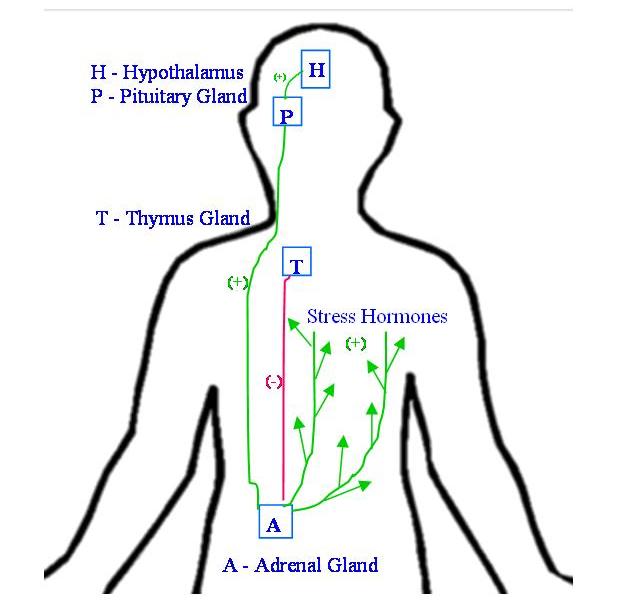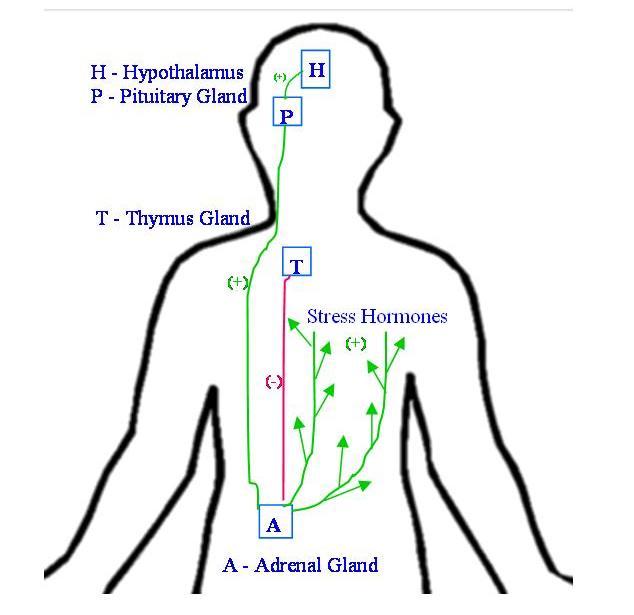Wellness Journey with Joe
Week 15 - The Stress Response
11/7/2015

** ALERT - This is one of my most important posts regarding the effects of the mind/body connection. However, there is a LOT in this post!! Take your time with the information, we'll take a couple weeks explaining this phenomenon. If you get tired or frustrated with the volume of information on this page at least go to the end and read the "Effect of Stress Hormones" and "So Here's The Problem."
________________________________________________________________________________________________
Now it is time for you to understand a bit of physiology. Our body's stress response has saved our species time and time again through the ages, to the point that without it we would have become extinct long ago.
It is the two edged sword I alluded to earlier, where it was designed to save our lives, but if it is turned on too often or for too long a period it can render you susceptible to catastrophic consequences.
It is my belief that understanding this phenomenon will do as much as anything for you to get to the bottom of your stress and improve your mental health. This week's offering may take a bit intellectual gymnastics but it will be worth it, so hang in there with me!
The Body’s Stress Response
Fight or Flight Mechanism
also known as
General Adaptation Syndrome


Fight or Flight
We have talked much about how the body (ultimately the cells) tends to seek a balanced state. We call this dynamic HOMEOSTASIS. How glorious it is for our survival that we have such an incredibly effective internal dynamic at work, controlled by our autonomic nervous system, that seeks to keep us healthy without our even having to think about it!
Our responsibility in securing the preservation of this dynamic is simply to feed the body correctly, to challenge it with enough exercise to keep it toned, and to take control of our stressful lives.
Not All Stress is Bad
 Regarding stress it should be noted that not all stress is Regarding stress it should be noted that not all stress is bad. We stress our muscles in weight training and the result is increased strength. We stress our minds when we read and the result is increased intelligence. This type of stress is referred to as eustress. bad. We stress our muscles in weight training and the result is increased strength. We stress our minds when we read and the result is increased intelligence. This type of stress is referred to as eustress.
However, when we are faced with imminent danger our body is in distress, and initiates a cascade of processes that prepare the body  to react. to react.
This response to distress, called the stress response, is associated with homeostasis and also controlled by the autonomic nervous system, the automatic part of the nervous system that keeps you breathing,. for example, even when you are sleeping. The stress response is one of many sophisticated survival mechanisms developed through evolution.
Hans Selye
Hans Selye (1907-1982), an Austrian-Canadian medical doctor and researcher, showed how stress is not some vague concept, but a specific physiological  phenomenon that exhibits the same physical characteristics, NO MATTER WHAT THE STIMULUS. In other words, whether it’s a bear coming at you, or if being called upon to answer a question in class, or if attempting to do a flip off the diving board when you’ve never done one before, the physical response is always the same. The degree or intensity of response among the organs, glands, and hormones involved may vary, but the mechanism itself is the same. phenomenon that exhibits the same physical characteristics, NO MATTER WHAT THE STIMULUS. In other words, whether it’s a bear coming at you, or if being called upon to answer a question in class, or if attempting to do a flip off the diving board when you’ve never done one before, the physical response is always the same. The degree or intensity of response among the organs, glands, and hormones involved may vary, but the mechanism itself is the same.
Growth and Protection
Before examining the mechanism of the stress response we need to understand a couple things. Cell function and homeostasis are all about survival. And all survival mechanisms can be broken down into one of two categories: Growth and Protection. Our bodies’ cells spend their entire day functioning in response to these two categories.
GROWTH – As an adult you may believe that you are now fully grown. But did you know that every day billions of cells in your body have worn out and need to be replaced? By replacing these cells you actually continue to “grow” throughout your entire life. Red blood cells that carry oxygen to your tissues have a 120 day lifespan; skin cells are being replaced daily, bone cells are replaced necessarily to maintain the strength of your skeleton; and the entire lining of your gut is replaced every 72 hours. This turnover in cells requires a tremendous amount of your energy.
PROTECTION - In the Nutrition Module of my Wellness Mini-Course located on this website I taught how individual cells have protein receptors imbedded in their cell membranes (outer cell covering) that read their local environment, deciding what to let in the cell and what to keep out. Well, the multi-celled human organism (our body) reads and interprets its environment through the five senses as part of the nervous system. It is the job of the nervous system to monitor the environmental signals, interpret them and coordinate behavioral responses. In the case of a threatening environmental signal the nervous system alerts the trillions of community cells throughout your body of a needed response; the stress response, a protection response.
…more on growth and protection
Single cells act just like the whole body. For example, when nutrients are introduced into a petri dish of single cells the cells will gravitate toward the nutrients, just as humans gravitate toward breakfast, lunch and supper.

Conversely, when a toxin is added to the cells’ environment they retreat from the toxin, just like humans retreat from spoiled smelling milk, strangers in dark alleys, or a rabid dog.
Gravitating toward nutrients, whether it's a cell or the
entire individual, characterizes a growth response.
Retreating from toxins characterizes a protection response.
The Relationship Between Growth and Protection
It is important to know that a cell cannot exhibit both growth and protection at the same time. The protection response overrides the growth response, allowing the cell to put all its energy at that moment into surviving. The cell is not concerned with growing while at the same time its very existence is being threatened!
This concept will prove to be very important in your understanding of the MIND-BODY connection.
OK, not to confuse you but
there is one more fact to understand.
The body actually has two systems designed for protection:
1. Stress Response/Fight or Flight/General Adaptation Syndrome, or the fancy name: Hypothalamic-Pituitary-Adrenal Axis
a) This system deals with EXTERNAL stressors
2. The Immune System
a) This system deals with INTERNAL stressors.
- bacteria, virus', and other invaders.
… and now on to the Stress Response…
The Stress Response, aka the Fight of Flight System, the General Adaptation Syndrome, and now I've introduced the term, The Hypothalamic-Pituitary-Adrenal Axis which includes the Hypothalamus of the brain, the Pituitary Gland and Adrenal Glands. It's not important that you memorize these structures, just know that there is an interconnected system secreting hormones which prepare the body to ACT!!
Hypothalamic-Pituitary-Adrenal Axis
So here is what happens:
- One of your five senses detects a stress. Your brain interprets it as a stress and sends a nerve signal to the hypothalamus.
- The hypothalamus secretes a hormone, CRF, that enters the pituitary gland. The hypothalamus is closely associated with the pituitary gland both in location and function.

- In response the pituitary gland secretes a hormone, ACTH which travels via the blood stream to the adrenal glands.
- The adrenal glands then secrete stress hormones, including cortisol and adrenalin, into the blood stream.
- The stress hormones are what alert body structures to take on a defense posture, a state of “protection”, providing us with great physical power to fend off or flee danger.
- Stress hormones also shut down the immune system!
|
HPA SYSTEM
Hypothalamic-Pituitary-Adrenal Axis
HYPOTHALAMUS – An almond sized brain structure that links the nervous system to the endocrine (hormone) system. It regulates body temperature, thirst, hunger, fatigue, our biological clock, blood pressure and immune responses, among other things.
CRF – (Corticotropin Releasing Factor) – The hormone released by the hypothalamus in response to stress that activates the secretion of ACTH from the pituitary gland.
PITUITARY GLAND – the “master gland” of the body that secretes hormones to the body’s other major glands, controlling their function.
ACTH –(Adrenocorticotropin Hormone) The hormone secreted by the Pituitary Gland instructing the Adrenal Glands to secrete stress hormones.
ADRENAL GLANDS – Sit atop the kidneys, and are responsible for releasing the hormones cortisol and adrenaline (epinephrine) in conjunction with stress.
STRESS HORMONES – Chiefly cortisol and adrenaline (epinephrine), these hormones initiate the “fight or flight” response to a threat, sounding the alarm and putting the body in a state of “protection”.
IMMUNE SYSTEM – The body’s defense against infectious organisms and other invaders. White blood cells, produced and stored in the bone marrow, spleen and thymus gland, are transported via the blood stream and lymphatic system. Once an invading organism is detected antibodies (specialized proteins!) are produced and, together with the white blood cells, are sent to destroy the invaders.
|
Effect of Stress Hormones
Digestive system – constrict blood vessels here, shutting down digestion. No need to be digesting food when you are running or fighting! Both energy and blood are needed elsewhere.
Skeletal muscles – dilate blood vessels here. The muscles need immediate oxygen and sugar, and lots of it, now!
Heart rate and output – Heart beat increases, which increases blood volume and increases blood pressure. This allows rapid delivery of the stress hormones and energy substrates.
Emotion centers – Stress hormones activate the amygdala, the emotional center of the brain, increasing anxiety.
Sensory systems – The body’s sensations are heightened; again, to increase alertness in order to take in as much immediate information as possible, and then reacted to by the instinct and reflex centers, not the critical reasoning centers.
Blood glucose levels – Insulin resistance occurs in order to leave the sugar (glucose) in the blood for an available energy source.
Blood fat and cholesterol levels – Fat is released into the blood stream as the stress hormones are transported by fat molecules.
Immune system – the stress hormones shut this system down. The immune system’s job of attacking internal invaders (viruses and bacteria, etc.) also involves a tremendous amount of energy. (Think of how run down you feel when fighting a cold or flu.) This energy exerted at a time of imminent threat is irrelevant, therefore the body shuts this system down and diverts that energy into the fight or flight mechanism.
Concentration – the fight or flight response is instinctual, a reflex reaction. The parts of the brain involved in reflexive instinctual action are the midbrain and the hindbrain, not the forebrain where consciousness, reasoning and logic resides. The hindbrain is activated at the expense of the forebrain during stress. Alertness is certainly heightened but memory and concentration is diminished.

The stress response is designed to radically
increase strength and heighten alertness in
order to respond effectively to an immediate
threat. Once the threat is gone the body
returns to its normal physiology, allowing
growth and repair to resume.
HOWEVER, we cannot be Superman all the time!!
This life-saving dynamic is VERY energy consuming
and NOT INTENDED to remain engaged for long.
It is designed to focus energy so intensely that you become super-human for a short time, but engaged too long and
you will wear out!
So here’s the problem!!
 In today’s world we are besieged with stressors. In today’s world we are besieged with stressors.
Not only from work, family, and overloaded schedules, but from less easily identifiable stressors. Twenty four hour news channels exaggerate news reports to keep you tuned. World news reminds us of serious threats. Advertisers constantly try to convince you to buy things you do not need. A popular strategy for the profit makers is to: Create The Fear Then Sell The Product!
What we also are not aware of are the many stressors besides  emotional stress, including a poor diet, too much sitting, and lack of exercise, that can also initiate the stress response. They may not be immediate life threatening stresses yet these worries and poor habits will initiate the stress response resulting in chronically elevated stress hormones. emotional stress, including a poor diet, too much sitting, and lack of exercise, that can also initiate the stress response. They may not be immediate life threatening stresses yet these worries and poor habits will initiate the stress response resulting in chronically elevated stress hormones.
Our consumption based society wants more, more, more! This leads to symptoms caused by a chronically engaged stress response. So many of us drink coffee, eat candy bars and take medications to keep us going during the day but then need sleeping pills to help us sleep at night. We take antacids to calm our stomachs, ibuprofen to relieve chronic inflammation, and blood pressure medication to keep our blood pressure in check.
Consider the consequences
of a chronically engaged stress response:
Remember Hans Selye? No matter what the stress, the body always acts the same when it engages the stress response. Read the list above as to what happens normally during stress and then consider what happens when it isn't turned off?
Now you have chronically heightened blood glucose,
high blood pressure, poor digestion, high anxiety,
high circulating fat concentrations,
insulin resistance, weakened immunity,
decreased ability to concentrate,
loss of memory, etc.
All normal when the body is trying to save you
but when it's not turned off
it wears your defense system down.
Now consider the major killers
in our society today:
HEART DISEASE, STROKE, CANCER, DIABETES
And the major chronic problems:
Depression, obesity, anxiety, fatigue,
chronic pain, osteoporosis, fibromyalgia,
lack of sleep, decreased sex drive,
decreased fertility, indigestion,
accelerated aging, ADHD…
You see, these all are associated with a chronically engaged stress response!! Yes, there are certainly some genetic markers that are directly involved in some of those who contract these diseases but the majority of these problems we bring on ourselves. They are lifestyle diseases associated with an abnormally engaged stress response.
Most importantly, when we are under chronic stress our bodies and our lives are functioning in a state of defense and protection instead of growth.
Not only is the ability to produce the cells
needed for repair impeded,
but our ability to grow intellectually
and emotionally is stifled also.
We are simply existing, not living!
So, What Can You Do?
|

